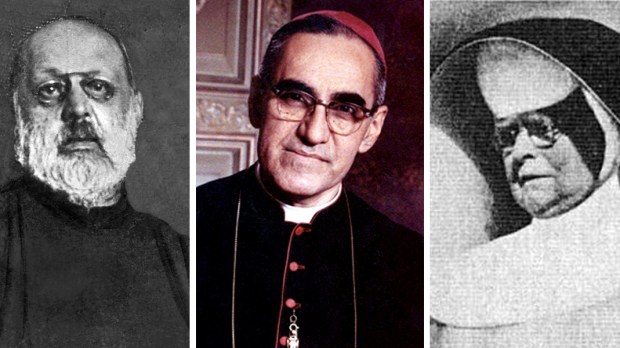With the stigma surrounding mental illness, many Christians feel quite sure that their mental health struggles are a result of their own sin, calling depression a “failure to hope” and insisting that mental illness can be prayed away.
Mercifully, this is not the Catholic position. The Church understands that health struggles have many causes, that treatments like therapy and medication are often necessary, and that those who suffer aren’t in any way less holy than those who don’t. This is true of mental health as well as physical.
But those living with mental illness don’t always realize that they’re not alone in their struggle; though many of the saints lived before modern methods could diagnose their mental health issues, we have others who clearly suffered from mental illness. During this time when many are struggling with their mental health even more than usual, it helps to know that there are saints walking alongside us.
St. Oscar Romero (1917-1980) struggled with scrupulosity his whole life, but when he was 49 a psychiatrist diagnosed him with obsessive-compulsive disorder. Already a priest, Romero had the humility to undergo psychoanalysis and seek counseling at a time when mental illness was spoken of only in hushed voices. He continued to deal with his OCD throughout his life, including during his work as archbishop fighting for the rights of the oppressed, for which he was ultimately killed.
Venerable Rutilio Grande (1928-1977) grew up in poverty in El Salvador before entering the Jesuits. He struggled with mental illness throughout his formation, dealing with chronic anxiety and scrupulosity before his first nervous breakdown. During that time, he was diagnosed with catatonic schizophrenia, a condition that is often fleeting but was likely the result of years of anxiety and trauma. He was hospitalized twice for the same illness but allowed to continue in his formation. He was ordained a Jesuit priest but continued to suffer from anxiety and scrupulosity, for which he saw a counselor. He was a champion of the poor in spite of government threats and was martyred for his work.
St. Alphonsa Muttathupadathu (1910-1946) was a Syro-Malabar nun in India who lived with chronic illness for most of her life. When an intruder broke into her cell at the convent, she was so traumatized by the experience that she had a nervous breakdown. She lost her memory and her ability to read and write, living with amnesia for nearly a year in the wake of the shock. After receiving anointing of the sick, she was healed of what seems to have been PTSD, but died a few years later.
Bl. Enrico Rebuschini (1860-1937), an Italian Camillian priest, lived with depression all his life. He experienced several depressive episodes that required hospitalization, in his 20s, his 30s, and even into his 60s. Throughout his life he continued to suffer from depression, but it didn’t impact his cheerful personality, however much it may have cost him privately.
Servant of God Rose Hawthorne Lathrop (1851-1926) was a New York socialite when she gave birth to her first son, Francis. Rose suffered from post-partum depression and psychosis after Francis’ birth, to the point that the baby was taken from her and she was sent to an asylum for several months. After her treatment, she was able to return home, quite healed. Later, after the death of her young son and her separation from her alcoholic husband, Rose began to nurse the poor. She founded a Dominican order of nursing Sisters after her estranged husband’s death.
St. Albert Chmielowski (1845-1916) was a Polish revolutionary, then a famous painter, before leaving behind fame to found a community of Franciscans to serve the poor. Before founding his order, he entered the Jesuits; during his novitiate, he had a nervous breakdown and was hospitalized. Albert spent nine months in a psychiatric hospital, diagnosed with “hypochondria, melancholy, religious insanity, anxiety, and psychic oversensitivity.” Even after his release, Albert remained melancholy and mute, but one day (16 months after the crisis began), he suddenly arose, left town for confession and communion, and returned in excellent spirits. Unlike many who deal with mental illness, he never seems to have suffered from depression again.
There are others, of course, like St. Louis Martin, whose dementia late in life caused hallucinations and paranoia that compelled his daughters to send him to a psychiatric hospital for several years. Though given no diagnosis, Bl. Sebastian Valfré was plagued by the certainty that he was headed for damnation, and St. Jane Frances de Chantal experienced lifelong doubt and depression that were initially triggered by the death of her husband. The stories told of St. Flora of Beaulieu and St. Mary Magdalen de’ Pazzi suggest that they, too, struggled with depression. Venerable Matt Talbot was an alcoholic, while St. Mark Ji Tianxiang was addicted to opium. Even St. Albert the Great seems to have had Alzheimer’s at the end of his brilliant life. Not one of them was culpable for their mental conditions. And while some were freed during their lives, all of them now live eternally without anxiety or compulsion or trauma.

Read more:
3 Saints who may have had autism spectrum disorder

